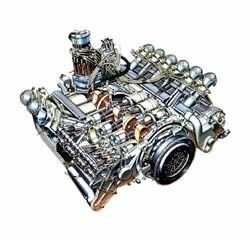sorry not the best drawing, but you will see it.

some info from ultimate cars
>>>>>
A mere five years after last drastically changing the regulations and for the fourth time in less than two decades, the sport's governing body (CSI) was at it again for the 1966 Formula 1 season; once more rendering all racers of the previous season(s) obsolete. This time round, the displacement limit was doubled from 1.5 litres to 3 litres for Naturally Aspirated engines and forced induction was allowed again with a maximum displacement of 1.5 litres. Although the company was known for its conservatism, the rule changes had worked well for Ferrari 1952 and 1961 and as the three litre regulations seemed perfectly suited to the Italian manufacturer, success was expected again.
While most of the British teams, or 'Garagists' as Enzo Ferrari used to call them, had to rely on their engine suppliers to get ready in time, Ferrari had the advantage of doing everything in house. Unfortunately there was not enough time and/or money available for chief engineer Mauro Forghieri to start from scratch, so he used the 3.3 litre engine from the 275 P2 sports racer as a base for the new V12 F1 engine. Much of the engine block was carried over, but the single overhead camshaft head was replaced by a modern dual overhead camshaft unit, but still with just two valves per cylinder. The 300 bhp engine was installed in a beefed up version of the chassis used in the previous season to create the Ferrari 312 F1.
Even though only two other teams had three litre engines at the start of the season, Ferrari failed miserably to make their mark in a championship that seemed theirs for the taking. The new V12 engine proved so unreliable that the team was forced to field updated V6-engined cars in some races. Considering all this, it was quite remarkable that John Surtees and Ludovico Scarfiotti managed to win a race each. Surtees finished second behind Jack Brabham in the driver's championship and Ferrari in the constructor's championship behind Brabham. These might look like quite an achievement, but it is mainly due to the even poorer performance from the likes of BRM and Lotus, who campaigned the overly complex BRM H16 engines.
Behind the scenes Forghieri continued to work frantically to up the ante for 1967. Much work was carried out on the cylinder heads, which now sported three valves per cylinder, with two for the intake. The intake trumpets were installed between the camshafts and a wild bunch of beautiful 'spaghetti' exhausts were mounted inside the engine's V. All these changes significantly increased the performance, peaking at 390 bhp at 10,000 rpm. Forghieri also drastically modified the chassis to shed over 50 kg, bringing the 1967 version of the 312 F1 considerably closer to the 500 kg limit.
The season started off not too happy when 1964 World Champion John Surtees left the team. Sadly it did not get much better when Lorenzo Bandini died from injuries incurred at the Monaco Grand Prix and it got even worse when Mike Parkes was forced to retire from Grand Prix racing after suffering serious burns after a crash in the Belgian Grand Prix at Spa. Just four races into the season, much of the pressure was now on the very young Chris Amon and he did very well to achieve four third place finishes. Even though the Brabham team dominated once more through consistency, the Lotus team with the new Cosworth DFV engines were a bigger worry for Ferrari, which had dropped to fourth in the constructor's standings.
For 1968, the 312 F1 was further lightened and now came with a four-valve per cylinder engine producing 410 bhp. In this watershed season when Formula 1 cars first featured sponsors' stickers and wings, the Ferrari drivers were able to match the pace of the 'Garagists', but were almost always let down by poor reliability from the very stressed engine. Nevertheless Jacky Ickx took a victory in the French Grand Prix after a smart tactical decision. At the end of the season Ickx and Ferrari were fourth in both standings. Little changed for 1969 when a single car was campaigned by Amon, while Forghieri worked restlessly back at the factory on the all new flat-12 engined car for 1970. Amon finished the season in twelfth and Ferrari in fifth.
Even though starting the period with high hopes, Ferrari completed the first four years of the three-litre era with just three wins. The British teams were always one step ahead first with the incredibly reliable Repco enfines and later with the fully stressed Cosworth DFV V8. In the next years Forghieri continued to work to catch up and before the introduction of the Turbocharged Renaults, Ferrari was the only team that could successfully compete with the Cosworth powered 'kit-cars'.
<<<<<









